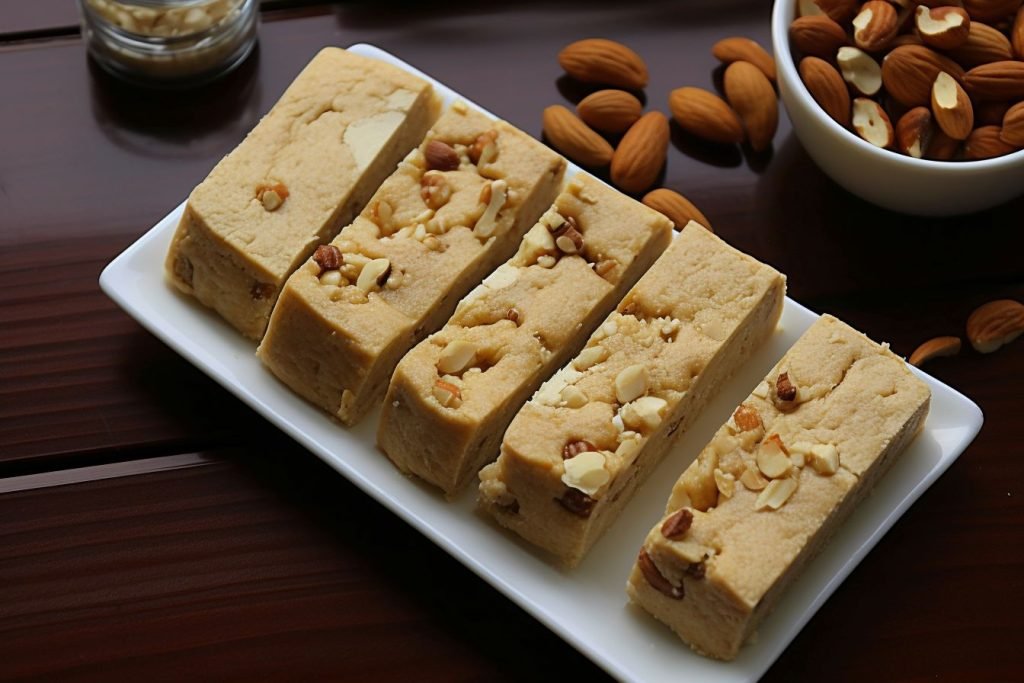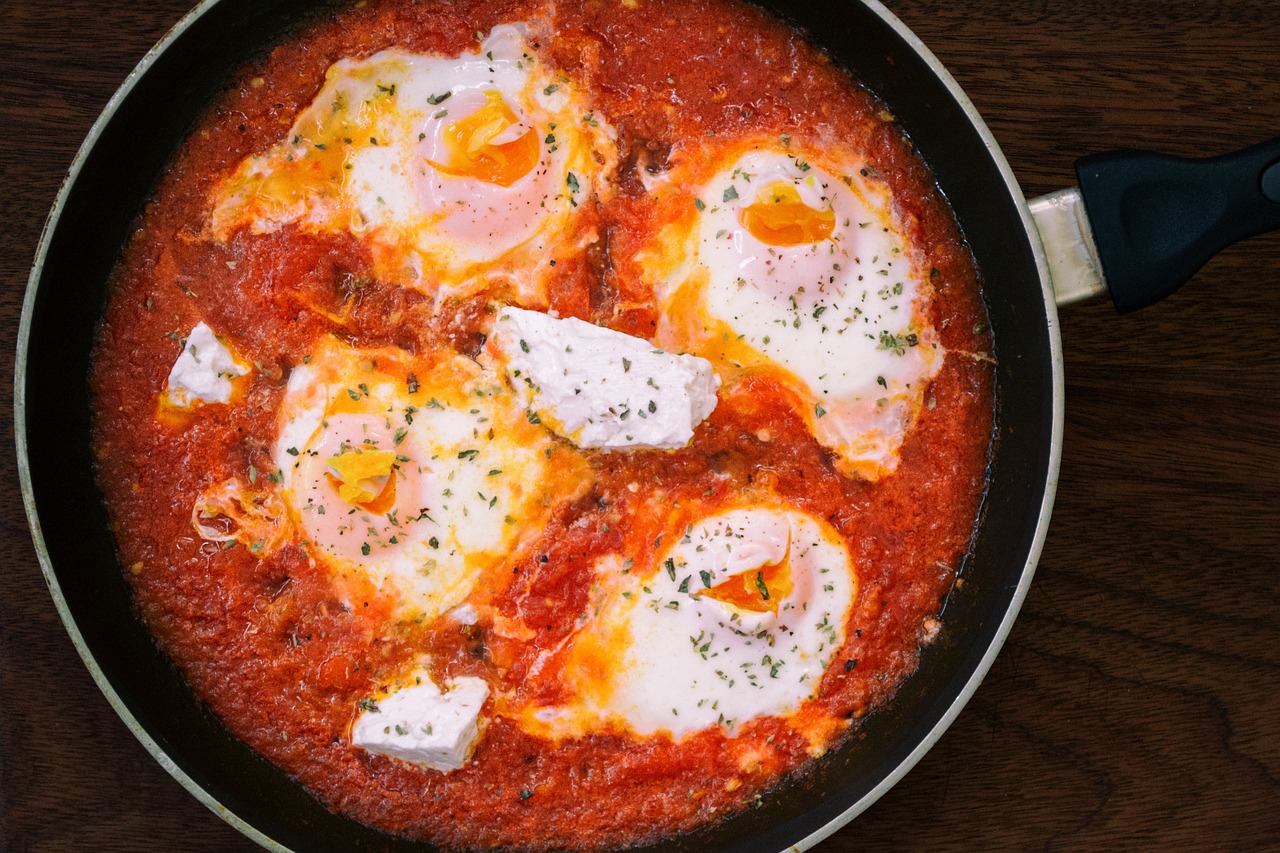Shakshuka with goat cheese is a delicious and easy-to-prepare dish that is perfect for breakfast, brunch, or even a quick dinner. This Middle Eastern-inspired dish is made with eggs poached in a spicy tomato sauce, and topped with creamy goat cheese and fresh herbs. It’s a hearty and satisfying meal that is sure to impress your family and friends.
To make it, you’ll need a few simple ingredients, including olive oil, onions, garlic, red bell pepper, cumin, paprika, harissa spice, canned tomatoes, spinach, eggs, goat cheese, and a few optional garnishes like za’atar spice and fresh herbs. The combination of these ingredients creates a flavorful and aromatic dish that is both healthy and delicious.
So if you’re looking for a new and exciting breakfast or brunch recipe, give this shakshuka version a try. It’s a crowd-pleaser that is easy to make and sure to impress.
What Is Shakshuka
Historical Background
Shakshuka has been around for centuries and has its origins in North Africa. It is believed that the dish was brought to Israel by Tunisian Jews in the 1950s. Since then, it has become a popular breakfast dish in Israel and has spread to other parts of the world.
The name “Shakshuka” comes from the Arabic word “shakshouka,” which means “a mixture.” The dish is traditionally made by cooking eggs in a tomato and pepper sauce. However, there are many variations of the dish, and it can be customized to suit individual tastes.
Cultural Significance
Shakshuka is more than just a dish; it is a representation of the cultural diversity in the Middle East. In Israel, it is a symbol of unity and is enjoyed by people of all religions and ethnicities.
Moreover, shakshuka is a versatile dish that can be eaten at any time of the day. It is a popular breakfast dish, but it can also be served for lunch or dinner. Some people even enjoy it as a late-night snack.
Ingredients:
- 2 tbsp of extra-virgin olive oil
- 2-3 small yellow diced onions
- 3 cloves of minced garlic
- 1 large (or two if small) red bell pepper, thinly sliced1 tsp of ground cumin
- 1 tsp of sweet paprika
- 2 tsp of harissa spice
- 2 x 400 g cans of crushed tomatoes
- 1/2 tsp of sea salt (more to taste)
- Freshly ground pepper, to taste
- A handful of baby spinach
- 3-5 large eggs
- 150 g of thinly sliced goat cheese, without the rind (chèvre)
- Za’atar spice, to garnish (optional)
- Flat-leaf parsley or other fresh herbs of choice, to garnish
How to make shakshuka with goat cheese?
- Start by preheating the oven to 375°F / 190°C degrees.
- In a big oven-safe frying pan, warm up some oil on medium heat. Add in some onion, garlic, and red bell pepper, and cook them gently until they become very tender, which usually takes around 20 minutes. Once the vegetables are cooked, add in some spices and stir them to combine.
- After that, pour in canned tomatoes, sprinkle in salt and pepper, and give it a good stir. Keep cooking until it starts bubbling. After that, toss in some spinach and stir until it’s all mixed in.
- Once the mixture is ready, carefully crack some eggs over the top of it. Sprinkle some goat cheese on top of the eggs and transfer the skillet to the preheated oven.
- Bake it for about 8-10 minutes, or until the eggs have set and the yolks are to your liking.
- Finally, remove the skillet from the oven and sprinkle some za’atar and fresh parsley on top. Serve the shakshuka with warm pita bread for dipping into the sauce.
Serving Suggestions
Accompaniments
- Crusty Bread: Serve shakshuka with a loaf of crusty bread to soak up the sauce. Sourdough, ciabatta, or baguette are all great options.
- Salad: A simple salad of mixed greens with a light vinaigrette can be a refreshing contrast to the richness of the shakshuka.
- Yogurt: A dollop of plain yogurt on top of the shakshuka can add a tangy creaminess that pairs well with the goat cheese.
- Olives: A small bowl of olives on the side can add a salty, briny flavor that complements the shakshuka.
Presentation Tips
- Use a Skillet: Shakshuka is traditionally cooked and served in a cast iron skillet. Not only does this make for a rustic presentation, but it also keeps the dish warm for longer.
- Garnish: A sprinkle of chopped parsley or cilantro on top of the shakshuka can add a pop of color and freshness.
- Serve Family Style: Shakshuka is a communal dish, meant to be shared. Serve it in the skillet at the center of the table with a stack of plates and let everyone dig in.
- Make it Your Own: Don’t be afraid to experiment with your serving suggestions. Try serving shakshuka with different herbs, spices, or toppings to make it your own.
Nutritional Information
this dish is not only delicious but also a nutritious meal that provides a good balance of macronutrients.
One serving (2 eggs, 1/2 cup tomato sauce, and 1 oz goat cheese) contains approximately:
- 315 calories
- 22g protein
- 18g fat
- 15g carbohydrates
- 3g fiber
- 10g sugar
- 470mg sodium
This dish is a great source of protein, which is essential for building and repairing muscles, and also helps to keep you feeling full for longer. The eggs in shakshuka are also a good source of choline, a nutrient that is important for brain health.
The tomato sauce used in shakshuka is rich in vitamins A and C, which are important for maintaining healthy skin and a strong immune system. Additionally, the lycopene in tomatoes has been linked to a reduced risk of certain types of cancer.
Goat cheese is a good source of calcium, which is important for maintaining strong bones and teeth. It also contains probiotics, which can help to improve gut health and boost the immune system.
Variations and Substitutions
Cheese Alternatives
While goat cheese is a delicious addition to shakshuka, other cheese options can be used as well. Feta cheese is a popular alternative that can be crumbled on top of the dish for a tangy flavor. For a creamier texture, try using ricotta cheese instead. If you prefer a milder taste, mozzarella cheese can also be used.
Additional Vegetables
Bell peppers, zucchini, and mushrooms are popular choices that can be sautéed with onions and garlic for added flavor. For a spicy kick, jalapeños or red pepper flakes can be added. Spinach or kale can also be added for a boost of nutrients.
Storing and Reheating
Refrigeration
After making this shakshuka, you may have leftovers that you want to store for later. The best way to store shakshuka is in an airtight container in the refrigerator. Shakshuka can last for up to 3-4 days in the refrigerator, but it’s best to consume it within 2 days for optimal freshness.
Reheating Instructions
When reheating shakshuka, it’s important to do so properly to maintain its texture and flavor. Here are some simple steps to follow:
- Remove the shakshuka from the refrigerator and let it sit at room temperature for 10-15 minutes.
- Preheat a skillet over medium heat.
- Once the skillet is hot, add the shakshuka to the skillet and spread it out evenly.
- Cover the skillet with a lid and let the shakshuka heat up for 5-7 minutes.
- Check the shakshuka and stir it occasionally to ensure it heats up evenly.
- Once the shakshuka is heated through, remove it from the heat and serve.
It’s important to note that reheating shakshuka in the microwave can cause it to become watery and lose its texture. Therefore, it’s best to reheat it on the stovetop.
Common Mistakes to Avoid
- Overcooking the eggs: One of the most important parts of shakshuka is the eggs. They should be cooked just until the whites are set and the yolks are still runny. If you overcook the eggs, they will become tough and rubbery.
- Using too much goat cheese: While goat cheese is a delicious addition to shakshuka, it’s important not to go overboard. Too much goat cheese can overpower the other flavors in the dish. Use just enough to add a tangy creaminess.
- Not seasoning properly: Shakshuka should be well-seasoned with salt, pepper, and any other spices you like. Don’t be afraid to taste and adjust as you go. It’s better to season gradually than to end up with a bland dish.
- Not using a good quality tomato sauce: The tomato sauce is the base of shakshuka, so it’s important to use a good quality one. Look for a sauce that is made with simple, high-quality ingredients. Avoid sauces with added sugar or other artificial ingredients.
- Cooking the peppers and onions for too long: While it’s important to cook the peppers and onions until they are soft and caramelized, be careful not to overcook them. They should still have some texture and bite.
Conclusion
I have to say, adding goat cheese to shakshuka was a game-changer. The creaminess of the cheese perfectly balances out the acidity of the tomatoes and the heat of the spices. It also adds a nice tangy flavor that complements the sweetness of the peppers and onions.
Overall, I highly recommend trying this version of shakshuka if you’re a fan of the classic dish. It’s easy to make, packed with flavor, and a great way to switch up your breakfast routine. Plus, it’s a great way to use up any leftover goat cheese you may have in your fridge.
If you’re looking for a complete meal, I suggest serving the shakshuka with a side of crusty bread or pita to soak up all the delicious sauce. You could also add some fresh herbs like cilantro or parsley on top for a pop of color and extra flavor.
In conclusion, shakshuka with goat cheese is a must-try dish for any brunch lover. It’s simple yet satisfying, and the addition of goat cheese takes it to the next level. Give it a try and let me know what you think!
Did you know? Halva with walnuts is the perfect dessert after having this shakshuka.
Get the recipe now (by clicking the image below):





